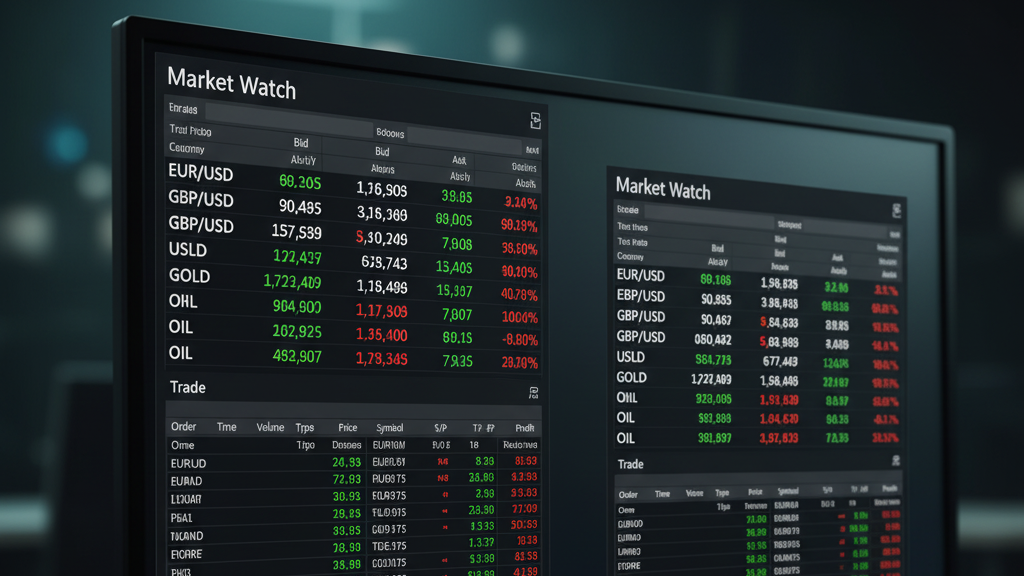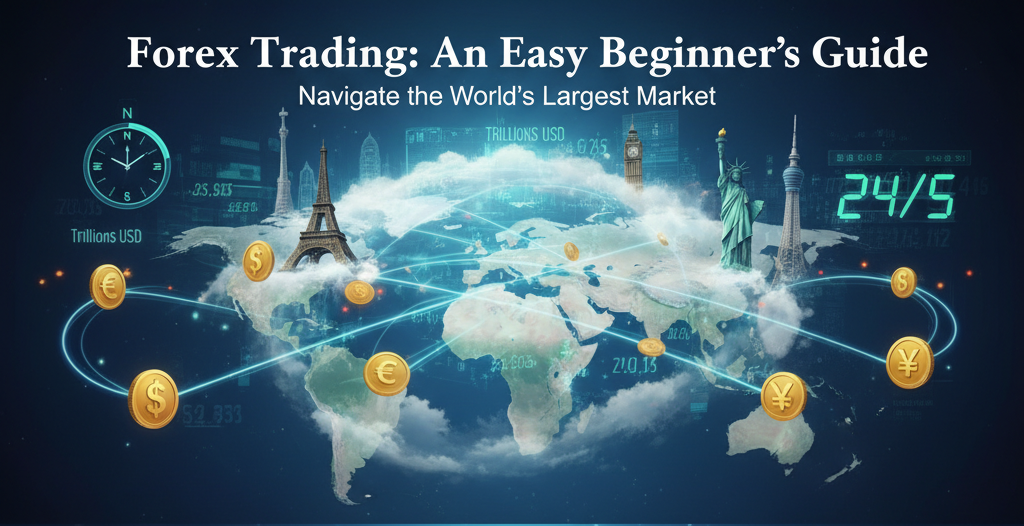Forex Trading: An Easy Beginner’s Guide to the World’s Largest Market
Introduction to Forex Trading
Hey future trader! Have you ever wondered what the words “Forex” or “FX” mean in the news or charts? You’re in the perfect place. I’ve been around online for quite some time and have even done a little Forex, so I know it can be a bit scary at first. But trust me, with the right guidance, this world is very interesting and rewarding.
Let’s make Forex trading easy together. I’m Jarvis from FastForex—sharing my experience and knowledge with you.
What is Forex Trading?
Think of Forex as the world’s currency swap shop—but on a massive scale. A simple everyday example: when you travel abroad and exchange your money for local currency, you’re technically doing a Forex transaction. Now imagine the same thing happening all over the world, but with huge sums of money, lightning-fast execution, and people trying to profit from price changes.
To put it simply, Forex trading is based on trading of currency pairs. If I believe the euro will climb higher compared to the dollar, I’d buy euros. If I’m right, I later sell them back for more dollars than I started with. If I’m wrong, I take a loss. That’s why smart risk management is non-negotiable.
Why Forex is Unique
Here’s what makes Forex stand out compared to other markets: it’s gigantic. We’re talking about the most liquid market on earth—bigger than stocks and crypto combined. Every single day, trillions of dollars move across it.
What this means for traders like us:
You don’t have to worry about being “stuck” in a position—there’s almost always someone on the other side ready to buy or sell.
The market never really sleeps. From Monday to Friday, you can find action 24 hours a day, whether you’re in New York, London, or Tokyo.
That flexibility and liquidity are what hooked me personally.
Why People Trade Forex
Everyone finds their own reason to dive into Forex, but for me, it started with flexibility. Unlike stocks that shut down after the bell, Forex is alive almost all week, day and night. I loved the fact that I could trade at odd hours, sometimes after work or even late at night, and it still fit around my life instead of the other way around.
Another thing that hooked me early on was the sheer activity. There’s so much money moving through the market that I never felt “trapped” in a position—I could jump in or out without worrying about crazy price gaps. Even the smallest moves, when traded with the right leverage, felt exciting because they actually added up. Of course, I also learned the painful side of that—leverage can make or break you—but that lesson stuck.
What also made it approachable was the low starting point. My first live account was tiny, more like the cost of a hobby than an investment, but it gave me real exposure to how the market works without me risking more than I could afford.
And maybe what’s kept me in it the longest is the constant learning curve. No two days in Forex are ever the same. One day, it’s a technical setup playing out; the next, it’s an unexpected piece of news shaking everything up. That unpredictability keeps me sharp—and honestly, it’s the reason I haven’t lost interest.
Forex Beginner’s Guide
Step 1: Education, Education, Education!
This guide is a start, but just the tip of the iceberg. One should read articles and watch videos on YouTube, as nowadays it is easily available. Then books and courses can also be insightful in learning. Technical analysis (charts and indicators) and fundamental analysis (economic news and data)—understand both.
My personal tip: Don’t just look at how to use indicators; understand why prices move. Understanding the “why” gives you a long-term edge.
Step 2: Choose a Reputable Forex Broker
Broker selection is crucial. A good broker offers a reliable platform, competitive spreads, good customer support, and licenses from a regulated authority (FCA UK, CySEC Cyprus, ASIC Australia).
What to Check in a Broker
When I was looking for my first broker, I honestly had no idea what I was doing. Every website promised “tight spreads” and “lightning-fast execution,” and it all sounded the same. What helped me figure it out were a few things I learned along the way:
Safety first: If a broker isn’t licensed by a proper regulator (like FCA, ASIC, or CySEC), I won’t even touch them. I’ve heard too many horror stories about unregulated brokers vanishing with people’s money.
Platform comfort: I started on MT4 because that’s what everyone recommended, and it worked fine for me. Later I tried MT5—it has more tools, but honestly, MT4 is still enough if you’re new. The platform you feel comfortable with matters more than fancy features.
Costs that add up: At first, I didn’t pay attention to spreads or commissions, and I wondered why my account barely grew even when I was right. Then I started paying attention to other miscellaneous charges incurred to me.
Customer support: The support desk should try to resolve your issues as soon as possible. If a broker ignores your emails, that’s a huge red flag.
Pairs available: I mainly trade EUR/USD, but I like to have other options open. Sometimes my favorite pair is dead quiet, and it’s nice to switch to something else without needing a new broker.
In short, a broker should feel like a reliable middleman—you don’t notice them much when things are going smoothly, but when there’s an issue, you want to know they’ve got your back.
Step 3: Open a Demo Account and Practice
Seriously, don’t skip this step! A demo account contains virtual money—you get risk-free practice in real market conditions. Understand the platform, test strategies, and learn to handle emotions.
My honest story: I traded on a demo account for months before investing real money. This helped me understand how emotions impact decisions, but for a real view of the psychology, you should put in a small amount of trade in real markets to learn.
Step 4: Develop a Plan
Every trade should have a roadmap. The roadmap should clearly outline:
- Which currency pairs to trade
- Which market timings to trade
- Fix entry model both risk and confirmation entry
- How to take profit
- How much percent of the capital to risk on a single trade
Step 5: Implement Risk Management
I have blown a lot of accounts during my beginner phase and then if there’s one thing that saved me from blowing up my account completely, it’s learning risk management the hard way. Early on, I treated trading like a slot machine—big lot sizes, no stop-loss, chasing quick wins. Spoiler: it didn’t end well.
Now I keep it simple:
- Risk per trade: I never let a single trade risk more than 1–2% of my account. So if I have $1,000, I’m only okay losing $10–20 on that trade. That way, even if I get five trades wrong in a row (which happens), my account survives.
- Stop-loss is non-negotiable: I used to skip stop-loss orders because I thought, “I’ll just close the trade manually.” Yeah… until the market moved fast and I froze. Now, the stop goes in as soon as I open a trade.
- Trade size matters: I prefer micro or mini lots until I’m 100% confident in a setup. It feels “small” sometimes, but small trades keep my head clear.
For me, risk management isn’t about sounding smart—it’s literally about staying alive in the market long enough to learn and improve.

Technical vs. Fundamental Analysis
I see a lot of traders argue about whether charts or news are more important. Honestly? Both matter, but I lean heavily toward technicals.
- Technical analysis: Most of my trades come from watching charts. I mark support and resistance zones, look for trendlines, and rely on a couple of indicators like RSI and moving averages. Nothing fancy. I like it because it gives me clear entry and exit points.
- Fundamentals: That said, I never ignore the news. I’ve had trades that looked perfect on the chart, only to blow up after a surprise interest rate decision. These days, I always check the economic calendar before trading.
My personal approach is: technicals tell me when to enter, fundamentals tell me when not to trade. If a big news event is coming, I stay out, no matter how good the chart looks. Learned that lesson the painful way.
Common Mistakes (I’ve Made and Seen!)
I’ll be honest—I’ve made most of these mistakes myself, and I still see beginners falling into the same traps:
Over-leveraging: I once used way too much leverage out of greed, and a single bad move nearly emptied my account. Don’t do it.
Trading without a plan: Random trades based on “gut feelings” are fun for about 10 minutes… until your balance tanks.
Skipping stop-loss orders: This is basically leaving your account unprotected.
Chasing trades: Overtrading because you want action rather than waiting for a solid setup is something I’ve been guilty of more than once.
Ignoring major news: I learned the hard way that even if your chart looks perfect, a sudden news release can wreck your trade in seconds.
Believing in magic systems: Anyone selling a “guaranteed profit” strategy is selling a fantasy. Losses are part of the game—accepting that keeps you grounded.
A Glimpse into My Trading Journal
Let’s say I’m watching the EU because it’s one of my favorite pairs.
Pre-Trade Analysis
First I will check for any major events or economic news in the eurozone or US regions.
Technical Analysis Setup
Technical Analysis: On my 1-hour chart, I see that EU is trending upwards. It has now pulled back slightly to a strong support level that also matches the 50-period moving average. The RSI shows that the pair is not overbought, meaning there is room for further upside. I also wait for some bullish candlestick pattern for my confirmation.
Trade Execution Plan
I will buy if EUR/USD breaks the recent high that was formed after the pullback.
Take-Profit (TP): My TP will target the previous resistance level so that my potential profit is at least double my potential loss, which is a reasonable RR (1:2 risk-reward ratio).
Stop-Loss (SL): My SL will be placed slightly below the strong support level, risking only 1.5% of my account.

Hey loved it bro ! keep doing
Bro agar yeh website mere dada ke time pe hoti , toh aj woh jinda hote !! love from heaven